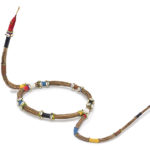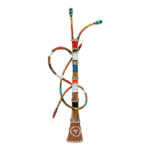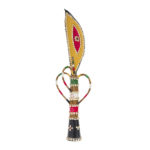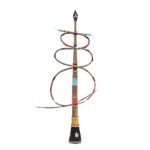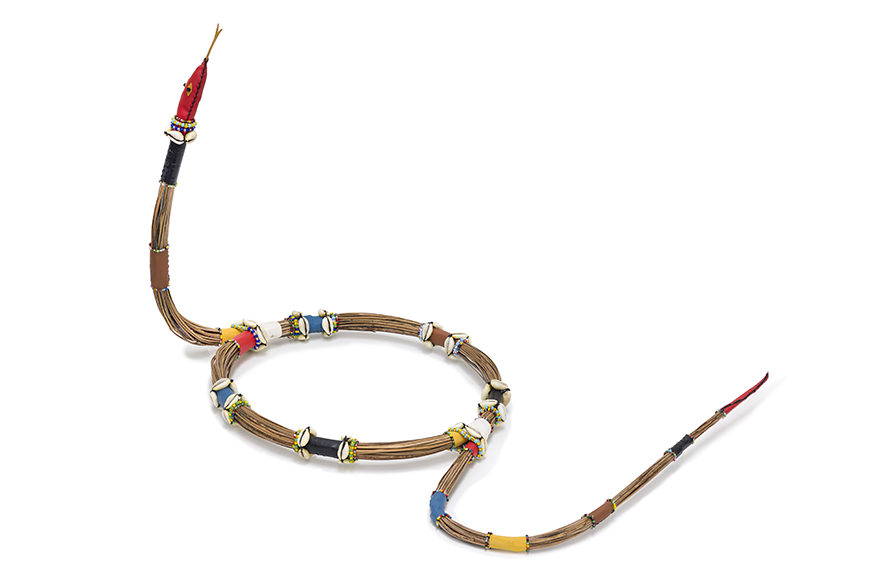The art of Mestre Didi projects itself with unique sensitivity, intense artistic significance and technical thoroughness, the aesthetic depth of a universe freely inspired by the sacred symbology of the African heritage, recreating tradition with immense innovation within the contemporary art world. His sculptures, done with several materials, are works of intense artistic significance by aesthetically re-creating a universe freely inspired by the sacred symbology of the African heritage.
In his work, an encounter of tradition and African heritage, identified through ancestry and the sacred, and the union with the contemporary art, brings to life an abstract-conceptual and emotional language, elaborated from the origins by its predecessors, making present past facts, to restore and renew life. His work contributes to retrace and recreate the entire cognitive emotional system of the egbé, both in relation to the cosmos and human condition, not only for an aesthetic re-creation, but also for its symbolic meaning.
The objects are not only material representations, but essentially emblems in which the sacred is represented. The fan does not bow before the wood, porcelain, clay, straw or stones, but before the sacred abstract, just as the Catholic does not worship the material image of saints and crucifixes, but the mystical essence they symbolize.
With his art, Mestre Didi creates and recreates with immense variety of form and senses of the sacred, having its characteristics impregnated with natural elements of symbolic content of the Afro-Brazilian universe, making a complex commentary on the nature of time, tradition and the new, it’s an art that humanizes the world by humanizing man.
Deoscoredes M. dos Santos, Mestre Didi, writer and plastic artist, was born in Salvador, Bahia, in December 2nd, 1917. He passed away in his hometown on October 6, 2013. With an artistic work of rich significance by aesthetically re-creating a universe freely inspired by the sacred symbology of his African heritage, Mestre Didi’s sculptures projects with unique sensitivity and technical minutiae, a mystical depth, recreating tradition with immense innovation within the aesthetic contemporaneity of art.
Your work promotes an encounter between tradition and African heritage identified through ancestry and the union with contemporany art, not only an aesthetical re-creation of myth, shape and materials used, but also for its deep symbolic meaning. How does this encounter happen?
With your art, Mestre Didi creates and recreates a religious universe with immense variety of form and senses, having its characteristics impregnated with natural elements of symbolic content of the Afro-Brazilian universe. How is this creation so intimately performed in sacred territory, without becoming ritual insertions, or with religious purposes, but exemplarily a sculptural art of deep contemporaneity?
It’s been said that your art is a complex commentary on the nature of time, tradition and the new, and that it’s an art that humanizes the world by humanizing man. What do you think about this opinion?
Performed via email, Mestre Didi put them together in one text, to reply them.
My mythical world, my way of seeing the world, is deeply rooted in my life experience.
The artwork come from this world, from my own way of seeing, living and associating. They are inspired by some of the traditional shapes, emblems inherited from the older ones, which, to have an actual religious value, must be properly consecrated.
My work is free, multiplying shape, colors and materials without any religious purpose. They show and manifest a particular cultural vision, a re-created timeline.
My art gives me joy and makes me truly happy and fullfiled. It’s connected to everything I love the most about life, its nature elements. These elements are deeply associated to our way of feeling and existing on earth, especially the trees, among which are the palm trees from which I extracted the basic material for my artwork, the taliscas or veins of its leaves, our ancestors, that arise from the earth, our great mother. Everything grows and renews itself. If my work humanizes, it’s because it it’s capable to touch your emotions, bringing through art the deep knowledge of a people, the Agbon – beauty and wisdom.
(interview/April, 2007)


